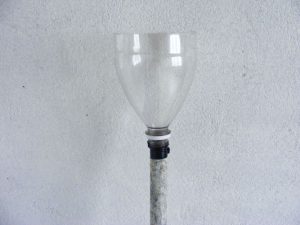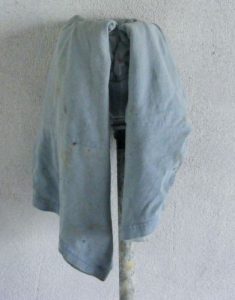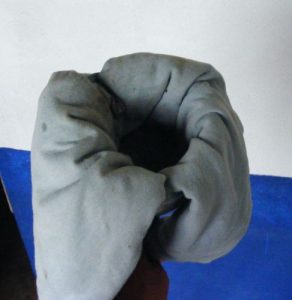So you have a light bulb in a high ceiling fixture and no ladder. What to do? Make your own light bulb changer.
Materials needed:
Broom stick with standard Acme threads
An empty 2 liter plastic soda bottle
An old cotton t-shirt
Small amount of tape (electrical, duct, masking, whatever)
Sharp knife
Steps:
1.) Cut the bottle approximately as shown in the photo. Be careful because this kind of plastic is tough. Both the knife and the plastic can cut you. You don’t need or want a smooth clean edge on the plastic. A ragged edge is fine. (see below)
2.) Screw the broomstick into the mouth of the bottle until it’s snug, then apply a wrap or two of tape as shown in the photo to make sure it stays in place.
3.) Take the old t-shirt and fold it once so there are four layers of material and carefully fit it into the bottle. What I do is fold the t-shirt then lay it over a light bulb and use the bulb to gently press the shirt into the bottle. Once the shirt is in place, you can replace bulbs all day long without readjusting the shirt.
4.) Now you’re ready to go. Gently press the tool up over the existing bulb and twist the broom stick counterclockwise to unscrew it. Put the new bulb into the tool and install it.
BE GENTLE! This device grips the bulb and gives a lot of leverage so it’s very easy to twist the bulb right off and break it. Fingertip pressure is all you need to hold the broom stick.
The way it works is the sharp edge of the bottle tends to grab the t-shirt material so the shirt doesn’t slip. When you twist, the cotton t-shirt material takes about a 1/8th turn wrap on the bulb and grips it. The harder you twist, the tighter it grips. A heavy cotton t-shirt works best and a dirty t-shirt grips better than a clean t-shirt.
This device works equally well on incandescent bulbs and spiral CFLs (compact fluorescents). For very small bulbs, fold the t-shirt twice before inserting it. For other shapes like long skinny CFLs you might try the same methods but with differently shaped bottles.




Recent Comments